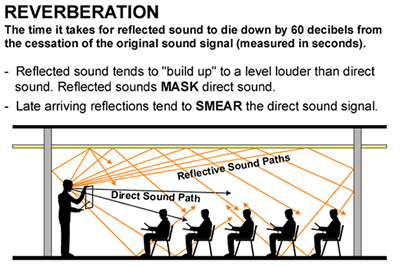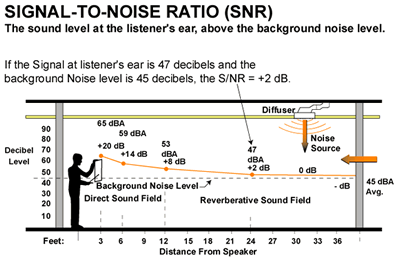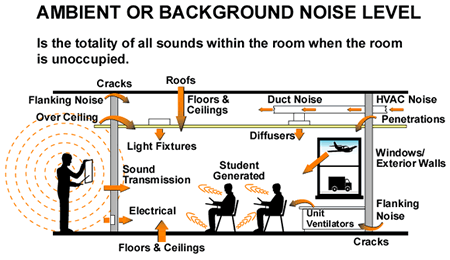Acoustical Standards Begin to Reverberate
Controlling Noise Within School Facilities
By Mike Dixon
Hearing, speech, and acoustical consultants and scientists believe that as many as one-third of all school students are missing up to 33 percent of verbal communications in class. It is not as much a question of being able to hear as much as it is a matter of being able to distinguish clearly and correctly what is being said.
Children are especially vulnerable to interference of the acoustical signal, with reverberation and background noise being the most notable culprits. They lack the knowledge and maturity to fill in missed words that can be rationalized by adult listeners.
The Access Board, a federal regulatory agency that grew out of the Americans with Disabilities Act (ADA), addressed the problem under the auspices of the legislative language of the ADA, voting to support the development of enforceable classroom acoustical standards by an ANSI-approved Acoustical Society of America working group. The proposed ANSI classroom acoustical standards currently are undergoing a final review before submission to the Access Board.
Setting the Standard
The standards are quite simple in their criteria, requiring a reverberation time of not more than 0.6 seconds at the mid-speech frequencies of 250, 500, and 1,000 Hertz in typical classrooms up to 10,000 cubic feet and 0.7 seconds for classrooms up to 20,000 cubic feet.
Background noise level in an unoccupied classroom should not exceed 35 decibels in the A-weighted scale (35 dBA).
An average student requires a Signal to Noise Ratio (S/NR) of at least +15 decibels. What this means is, at a student position, the speech level of the speaker must be 15 decibels above any background noise, including HVAC, traffic, and aircraft noise.
To increase speech intelligibility, it is critical to thwart both background noise and reverberation. Reducing the reverberation time is relatively simple and consists of no more than determining the existing reverberation time and then adding an appropriate quantity of sound absorbing materials. However, measuring the reverberation time can be costly, requiring sound equipment operated by an acoustical technician. On the other hand, measurements also can be calculated with reasonable accuracy using the well-established Sabine Formula. Several companies are capable of calculating the reverberation time at an affordable cost, often 70 to 80 percent less than field measurement fees.
Getting Treatment
The same calculations can be used to determine, during the design process, how much acoustical treatment is required. Armed with sufficient information, designers can select materials and finishes that will achieve the recommended reverberation time. A computerized acoustical analysis takes only a few minutes to process or model, thereby providing the school’s designer with reliable information upon which to base material selection decisions.
Wall, floor, and ceiling constructions should be selected on the basis of its ability to minimize the passage of sound through the construction systems. Sound-isolation performance ratings include the Impact Isolation Class (IIC) for floor assemblies as well as the Sound Transmission Class (STC) for airborne sound transmission for floors, walls, and ceilings. The higher the STC or IIC number, the better the sound-isolation characteristics will be.
Having selected a wall assembly, for instance, the wall should be airtight in order to achieve the anticipated acoustical performance rating. If there is a crack in the wall, more sound will pass through the crack than the rest of the wall combined. In the case of drywall partitions, it is common practice to jack the drywall up off the floor to achieve a nice tight joint at the ceiling line. In existing facilities, your own ear can be the best gauge of how well the room is sound-isolated. If you can hear sounds from the next room, this may be because the base molding is hiding a crack at the floor line. Every high-performance, sound-rated wall has to be caulked or otherwise sealed at the wall’s perimeter. The same precautions should also be applied to roof structures, exterior walls, windows, and doors.
Remediating noise sources from other areas within the school might involve gasketing doorframes with inexpensive foam gaskets and applying a drop seal on the bottom of the door. It might only involve sealing any sound leaks with an inexpensive caulking compound.
Educational audiologists and special education teachers have resorted to FM amplification as a means to compensate for poor classroom acoustics. There is no question that FM amplification systems can be of immense benefit to hard-of-hearing students and can be of even greater benefit when the acoustical environment is optimized. But FM sound field amplification should never be used as a permanent substitution for well-designed acoustics and noise control measures. In many cases, FM amplification systems are only a Band-Aid solution and may only serve to exacerbate an existing problem.
The proposed ANSI standards for classroom acoustics should be embraced by our nation’s educational decision-makers and school designers. Poor acoustics and noise control problems, for the most part, have their origins in the architecture of the building and thus demand architectural solutions.
For additional information, visit these Web sites:
www.access-board.gov
www.acoustics.org
Mike Nixion, Acoustical Standards Begin to Reverberate, Archives – Feature: Book Review, May/April 2002, in School Construction News Online [cited 9 August 2002] available from www.schoolconstructionnews.com; Internet







